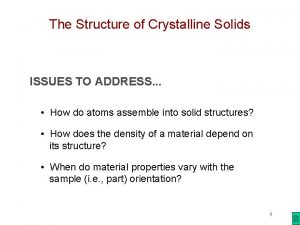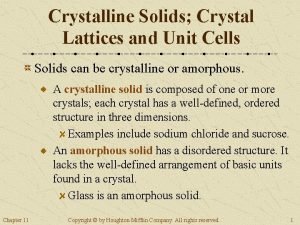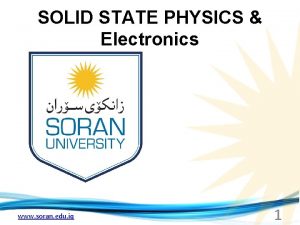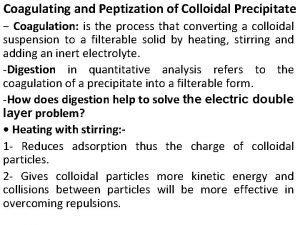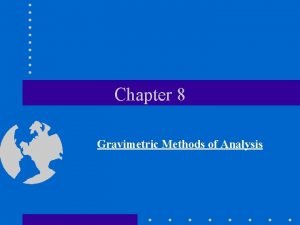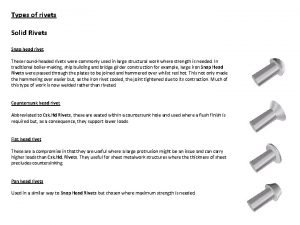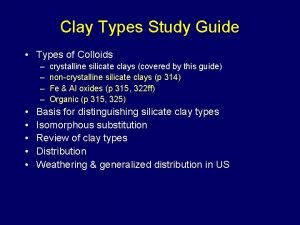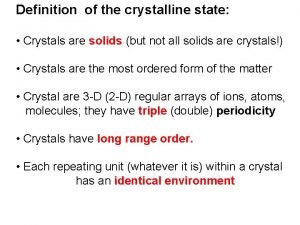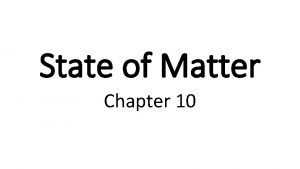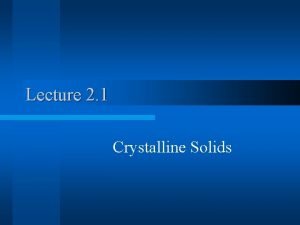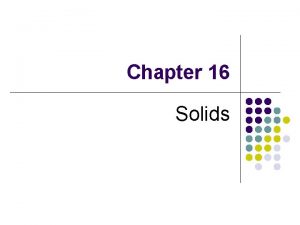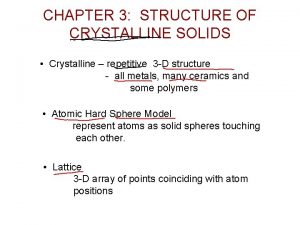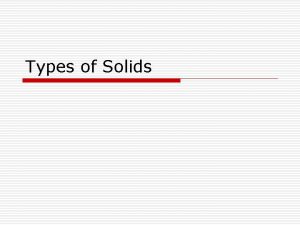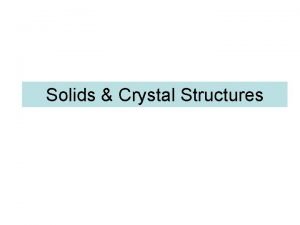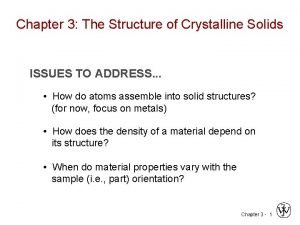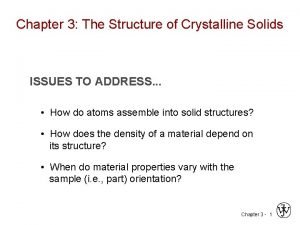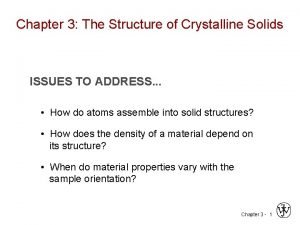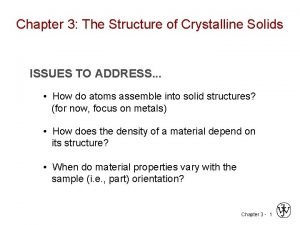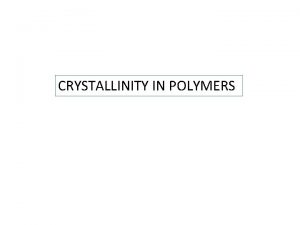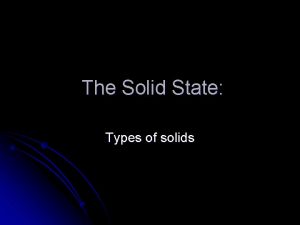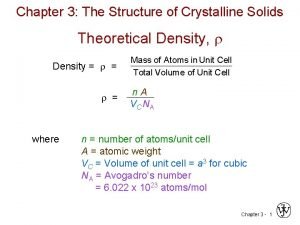Chapter 3 The Structure of Crystalline Solids ISSUES

















- Slides: 17

Chapter 3: The Structure of Crystalline Solids ISSUES TO ADDRESS. . . • How do atoms assemble into solid structures? • How does the density of a material depend on its structure? • When do material properties vary with the sample orientation? Chapter 3 - 1

X-ray diffraction photograph for a single crystal of magnesium. Photograph of a single crystal of magnesium that was cleaved (or split) along a (0001) plane—the flat surface is a (0001) plane. Also, the direction perpendicular to this plane is a [0001] direction. Mag Wheel—a lightweight automobile wheel made of magnesium. Chapter 3 - 2

After studying this chapter you should be able to do the following: Describe the difference in atomic/molecular structure between crystalline and noncrystalline materials. Draw unit cells for face-centered cubic, body-centered cubic, and hexagonal close-packed crystal structures. Derive the relationships between unit cell edge length and atomic radius for face-centered cubic and body-centered cubic crystal structures. Compute the densities for metals having face-centered cubic and bodycentered cubic crystal structures given their unit cell dimensions. Given three direction index integers, sketch the direction corresponding to these indices within a unit cell. Specify the Miller indices for a plane that has been drawn within a unit cell. Describe how face-centered cubic and hexagonal close-packed crystal structures may be generated by the stacking of close-packed planes of atoms. Distinguish between single crystals and polycrystalline materials. Define isotropy and anisotropy with respect to material properties. Chapter 3 - 3

Energy and Packing • Non dense, random packing Energy typical neighbor bond length typical neighbor bond energy • Dense, ordered packing r Energy typical neighbor bond length typical neighbor bond energy r Dense, ordered packed structures tend to have lower energies. Chapter 3 - 4

Materials and Packing Crystalline materials. . . • atoms pack in periodic, 3 D arrays • typical of: -metals -many ceramics -some polymers crystalline Si. O 2 Adapted from Fig. 3. 23(a), Callister & Rethwisch 8 e. Noncrystalline materials. . . • atoms have no periodic packing • occurs for: -complex structures -rapid cooling "Amorphous" = Noncrystalline Si Oxygen noncrystalline Si. O 2 Adapted from Fig. 3. 23(b), Callister & Rethwisch 8 e. Chapter 3 - 5

Metallic Crystal Structures • How can we stack metal atoms to minimize empty space? 2 -dimensions vs. Now stack these 2 -D layers to make 3 -D structures Chapter 3 - 6

Metallic Crystal Structures • Tend to be densely packed. • Reasons for dense packing: - Typically, only one element is present, so all atomic radii are the same. - Metallic bonding is not directional. - Nearest neighbor distances tend to be small in order to lower bond energy. - Electron cloud shields cores from each other • Have the simplest crystal structures. We will examine three such structures. . . Chapter 3 - 7

Simple Cubic Structure (SC) • Rare due to low packing density (only Po has this structure) • Close-packed directions are cube edges. • Coordination # = 6 (# nearest neighbors) Click once on image to start animation (Courtesy P. M. Anderson) Chapter 3 - 8

Atomic Packing Factor (APF): SC Volume of atoms in unit cell* APF = Volume of unit cell *assume hard spheres • APF for a simple cubic structure = 0. 52 a R=0. 5 a APF = close-packed directions contains 8 x 1/8 = 1 atom/unit cell Adapted from Fig. 3. 24, Callister & Rethwisch 8 e. Chapter 3 - 9

Body Centered Cubic Structure (BCC) • Atoms touch each other along cube diagonals. --Note: All atoms are identical; the center atom is shaded differently only for ease of viewing. ex: Cr, W, Fe ( ), Tantalum, Molybdenum • Coordination # = 8 Click once on image to start animation (Courtesy P. M. Anderson) Adapted from Fig. 3. 2, Callister & Rethwisch 8 e. 2 atoms/unit cell: 1 center + 8 corners x 1/8 Chapter 3 - 10

Atomic Packing Factor: BCC • APF for a body-centered cubic structure = 0. 68 3 a a 2 a Adapted from Fig. 3. 2(a), Callister & Rethwisch 8 e. R a APF = Chapter 3 - 11

Face Centered Cubic Structure (FCC) • Atoms touch each other along face diagonals. --Note: All atoms are identical; the face-centered atoms are shaded differently only for ease of viewing. ex: Al, Cu, Au, Pb, Ni, Pt, Ag • Coordination # = 12 Adapted from Fig. 3. 1, Callister & Rethwisch 8 e. Click once on image to start animation (Courtesy P. M. Anderson) 4 atoms/unit cell: 6 face x 1/2 + 8 corners x 1/8 Chapter 3 - 12

Atomic Packing Factor: FCC • APF for a face-centered cubic structure = 0. 74 maximum achievable APF 2 a a Adapted from Fig. 3. 1(a), Callister & Rethwisch 8 e. Chapter 3 - 13

FCC Stacking Sequence • ABCABC. . . Stacking Sequence • 2 D Projection B B C A B B B A sites C C B sites B B C sites • FCC Unit Cell A B C Chapter 3 - 14

Hexagonal Close-Packed Structure (HCP) • ABAB. . . Stacking Sequence • 3 D Projection c a • 2 D Projection A sites Top layer B sites Middle layer A sites Bottom layer Adapted from Fig. 3. 3(a), Callister & Rethwisch 8 e. • Coordination # = 12 • APF = 0. 74 • c/a = 1. 633 (for ideal) 6 atoms/unit cell ex: Cd, Mg, Ti, Zn Chapter 3 - 15

For the HCP crystal structure, show that the ideal c/a ratio is 1. 633. Chapter 3 - 16

1. Show that the base area of the unit cell for HCP is given by, 6√ 3 R 2. 2. Show that the atomic packing factor for HCP is 0. 74. Chapter 3 -
 Crystalline solid and amorphous solid
Crystalline solid and amorphous solid Atom and its structure
Atom and its structure Crystal solid and amorphous solid
Crystal solid and amorphous solid Crystalline or amorphous
Crystalline or amorphous Law of constancy of interfacial angle
Law of constancy of interfacial angle Crystalline substances
Crystalline substances Crystaline candy
Crystaline candy Crystalline solid
Crystalline solid Mixed crystal formation in gravimetric analysis
Mixed crystal formation in gravimetric analysis Peptization
Peptization Difference between colloidal and crystalline precipitate
Difference between colloidal and crystalline precipitate Gravimetric methods of analysis
Gravimetric methods of analysis Types of revits
Types of revits Crystalline solid and amorphous solid
Crystalline solid and amorphous solid Crystalline silicate clays
Crystalline silicate clays Definition of crystalline
Definition of crystalline Metallic crystal structure
Metallic crystal structure Destiny 2 crystalline formations
Destiny 2 crystalline formations

